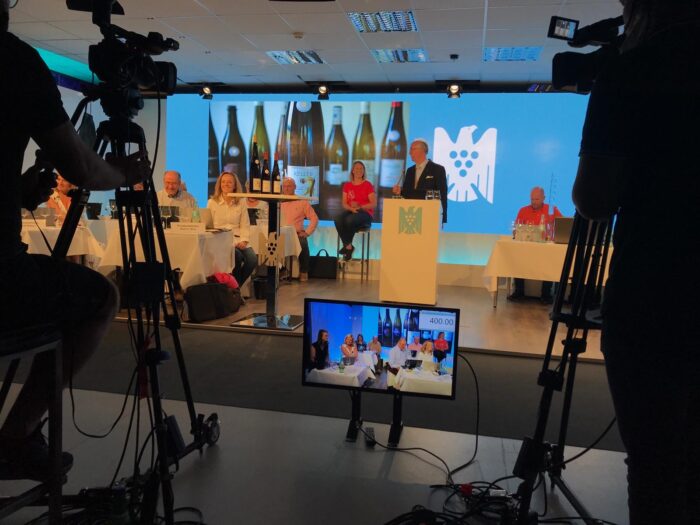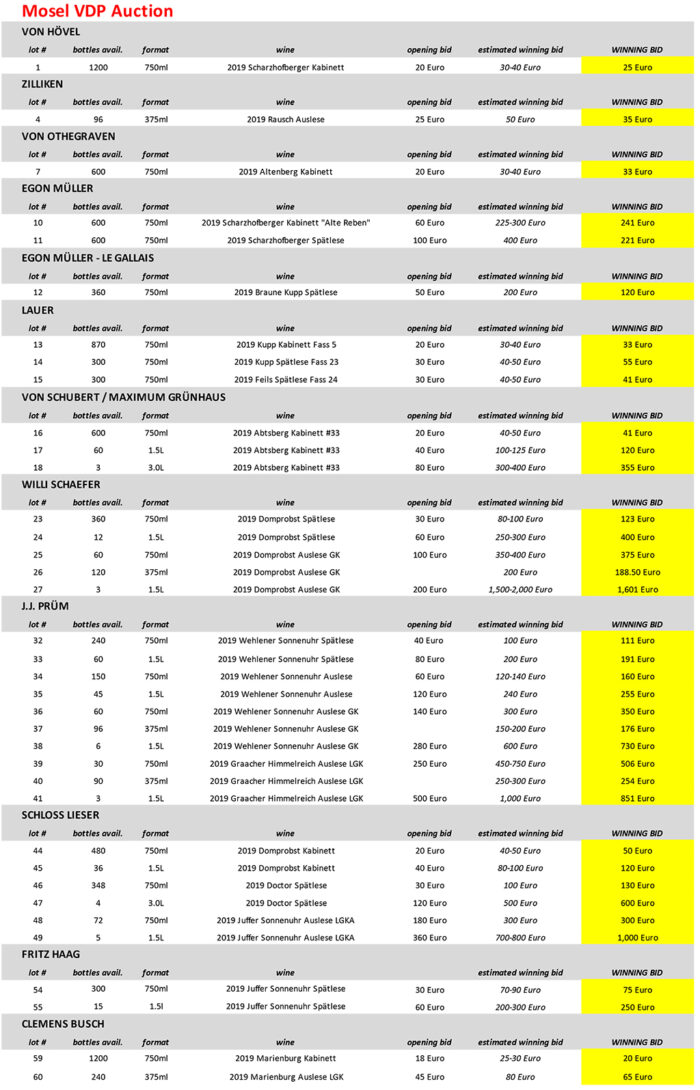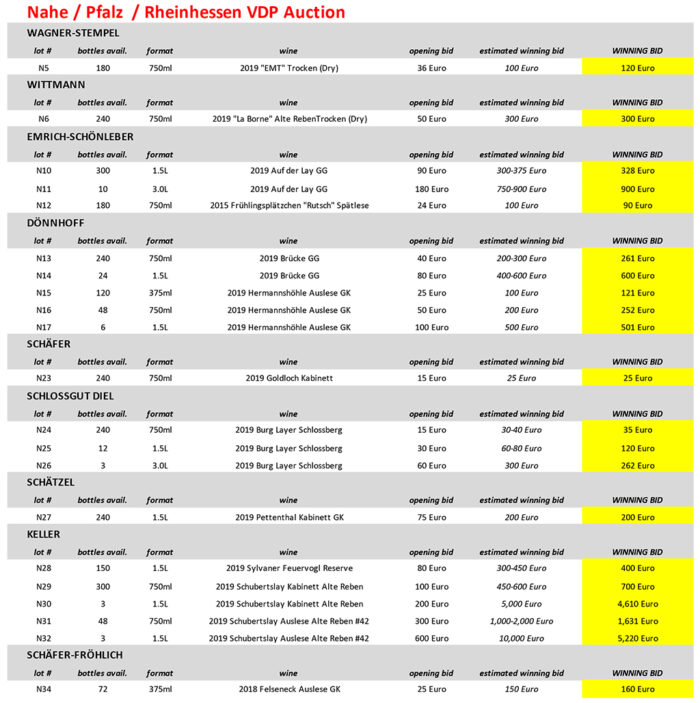The German wine auctions are a celebration both of the magic of wine (see our previous posts in the Newsfeed) and a celebration of community – the community of growers as well as the world-wide community of German wine fans.
This year, obviously, the many gatherings and tastings surrounding the auctions had to be canceled because of the pandemic. To some extent the script had to be completely rewritten to keep the auction safe; bravo to the VDP for changing as necessary and planning out everything so well. At least from my end as a buyer, there were few hiccups or technical frustrations. Everything worked as it should; it was a successful and fun auction.

You can find acurated list of auction results below; obviously if you’d like a full list I’m sure it’s available in thousands of places on the web. I’d try this search engine called “Google.”
There are a number of really easy and obvious things to say about the auction results. Let’s start there.
Bidding and prices were solid. Some lots pushed beyond expectations, others were a bit soft, but all in all it was a strong showing. While the reputation of the 2019 vintage brought bidders in and pushed prices up, the global pandemic and financial uncertainties kept things in check. My best guess is prices would have been 20-30% higher if the world was in a better place. From this perspective, I think there were a lot of good deals to be had this year.
Mosel Auction
There were some crazy deals to be had here. Florian Lauer’s auction wines remain wild values, though pricing is going up and was particularly strong for his Kupp Spätlese #23 Auction. From a qualitative standpoint, tasting side by side with the greats of the Saar, there is only one Kabinett I tasted that had the same lift and energy of Lauer’s bottling: Egon Müller’s Scharzhofberger “Alte Reben” Auction. And while Egon’s bottle is, stylistically, finer and more linear, more lithe, I don’t know if I’d say it’s just plain better. In any event, the 33 Euros for Lauer next to 241 Euros for Egon makes the value obvious.
While the style is a bit more luxurious, Clemens Busch’s wines are also ridiculous values: his 2019 Kabinett Auction went for only 20 Euros. Clemens is an amazing human doing amazing farming in an amazing vineyard – this wine is a steal.
The blue chip estates all showed fairly strong, including J.J. Prüm, Maximum Grünhaus/von Schubert, Schloss Lieser, Fritz Haag, etc.
I think special mention should be made of Willi Schaefer. This is a tiny gem of an estate, a true, family-run winery that combines in their own unique way true greatness with unquestionable humility. The wines have been wildly sought out by the German wine dork intelligentsia (myself included) for years and they are finally beginning to get wider recognition. In other words, the collectors with deep pockets are beginning to come for them. Prices for their auction wines were very strong this year (from what I have heard their 2019 collection is superb) and if I had to pick an estate that will enter the next level of pricing, it would be Willi Schaefer. The quality of the wine is just too high and the quantity of wine they make too low. I expect the pricing of this estate to rocket upward over the next few years. My advice (and this is advice I will personally follow): buy now.
For me, the most shocking moment of the Mosel auction was the pricing on Egon Müller’s Spätlese Auction. While the pricing for the Kabinett was, as mentioned, a strong 241 Euro (compared to 200 Euro last year), the Spätlese Auction went for 221 Euro, 20 Euros less than the Kabinett! The estate did not offer a Spätlese last year, so there is no true comparison, though it’s worth mentioning that bottles of the 2018 Auslese Gold Capsule last year sold for 1,950 Euro a bottle. I take this as just another sign that the hierarchy of the traditional Prädikat (which can be simplified to: Auslese is greater than Spätlese is greater than Kabinett), largely supported by the market and the critics for the last half-century, is crumbling further.
As climate change progresses, the paradigms are beginning to invert and my best guess is that very soon “Kabinetts” will be the most valuable, and rarest, wines. I’ve been arguing for years for the 100-point Kabinett, more as an expression of the value and seriousness that should be put on this category.
The market, as always, is the first to register this change (see discussion on Keller’s auction offerings below). The critics and press will soon follow.

Ahr | Nahe | Pfalz and Rheinhessen Auction
The joint auctions of the Ahr, Nahe, Pfalz and Rheinhessen are always particularly exciting. There are three estates that I consider perhaps the greatest practitioners of dry Riesling in Germany – Emrich-Schönleber, Keller and Schäfer-Fröhlich – and their offerings are all widely collected. But there is also a wide range of great estates with some serious deals to be had.
The Goldloch Kabinett of Joh. Bap. Schäfer went for only 25 Euro and I have it from good sources that this is a beautiful wine. Caroline Diel made a graceful and restrained Kabinett from Burg Layer Schlossberg that went for only 35 Euros. These are absurd prices; Kabinett of this quality at these prices won’t exist for much longer.
Wittmann’s dry Riesling from a small parcel in Morstein, called “La Borne” went for 300 Euro which I thought was strong; Schätzel’s Pettenthal Kabinett in magnum went for 200 Euro – a 100% increase from last year when I believe it went for only 100 Euro. The wine is very good but it’s reasonable to assume part of the pricing surge here has to do with Keller’s Pettenthal Kabinett, a rarity that has gotten very pricey in the past few years.
For absolutely world class, “greatest-wines-in-the-world” sorta wines, Emrich-Schönleber and Schäfer-Fröhlich still have the strongest deals going right now. Emrich-Schönleber’s Auf der Ley bottling (sourced from the top parcel of Halenberg) is, for the mineral head, one of the great dry German Rieslings, period. The fact that it went for only 328 Euros – in magnum format – is shocking and incomprehensible. Tim Fröhlich made one of the bolder moves of the auction, entering a vintage 2018er wine at an auction where, presumably, everyone was trying to get the much-lauded 2019ers. I think one of the great revelations of the next 10-20 years will be the quality of the top 2018ers, which have acidity, finesse, delicacy… and the wines of Schäfer-Fröhlich will be providing many of these revelations. This wine – an Auslese Gold Capsule, available only in half-bottle format – has the energy and lightness of a powerful Kabinett, just more layers and depth. It is a profound bottle, angular and forceful… it went for 160 Euro. For the quality of the wine, a steal.
And finally, well, there’s Klaus Peter and Julia Keller. The prices were again jaw-dropping and, what can I say, they deserve all the recognition they get. Keller, a profound advocate for the Kabinett (this is one of the reasons we’re good friends!), sent to auction only the second vintage from the Mosel Grand Cru Schubertslay. It went for 700 Euros. Keller also sent three magnums of this same wine to auction: the mags went for 4,610 Euros. An Auslese, also from the Schubertslay, commanded even stronger pricing, though I think this is a reflection of the rarity rather than a reflection of demand for the Prädikat (Keller sent 300 bottles of Kabinett to auction and only 48 bottles of Auslese).
Of particular note for the 2020 auction was the first-ever “Sylvaner” entry from Keller – an old-vine parcel in the Kirchspiel Vineyard bottled, in magnum only, as the “Feuervogl Reserve.” It went for 400 Euro, a respectable price that sets the foundation for a coming renaissance for this variety, perhaps the greatest white wine grape after Riesling and one that is profoundly misunderstood. You will hear more about Sylvaner in the coming years and it wouldn’t shock me to see some Sylvaner entries in upcoming auctions, now that Keller has, once again, set a new standard.
